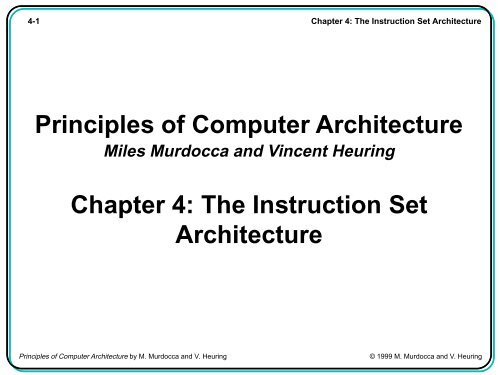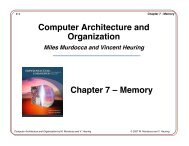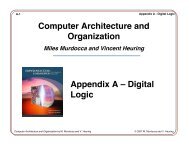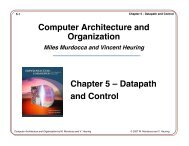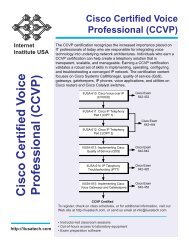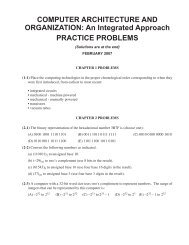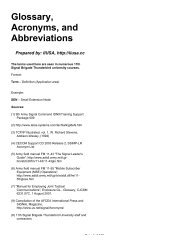Chapter 4: The Instruction Set Architecture - 10/31/2013 02:13:31 ...
Chapter 4: The Instruction Set Architecture - 10/31/2013 02:13:31 ...
Chapter 4: The Instruction Set Architecture - 10/31/2013 02:13:31 ...
Create successful ePaper yourself
Turn your PDF publications into a flip-book with our unique Google optimized e-Paper software.
4-1<br />
<strong>Chapter</strong> 4: <strong>The</strong> <strong>Instruction</strong> <strong>Set</strong> <strong>Architecture</strong><br />
Principles of Computer <strong>Architecture</strong><br />
Miles Murdocca and Vincent Heuring<br />
<strong>Chapter</strong> 4: <strong>The</strong> <strong>Instruction</strong> <strong>Set</strong><br />
<strong>Architecture</strong><br />
Principles of Computer <strong>Architecture</strong> by M. Murdocca and V. Heuring<br />
© 1999 M. Murdocca and V. Heuring
4-2<br />
<strong>Chapter</strong> 4: <strong>The</strong> <strong>Instruction</strong> <strong>Set</strong> <strong>Architecture</strong><br />
<strong>Chapter</strong> Contents<br />
4.1 Hardware Components of the <strong>Instruction</strong> <strong>Set</strong> <strong>Architecture</strong><br />
4.2 ARC, A RISC Computer<br />
4.3 Pseudo-Ops<br />
4.4 Examples of Assembly Language Programs<br />
4.5 Accessing Data in Memory—Addressing Modes<br />
4.6 Subroutine Linkage and Stacks<br />
4.7 Input and Output in Assembly Language<br />
4.8 Case Study: <strong>The</strong> Java Virtual Machine ISA<br />
Principles of Computer <strong>Architecture</strong> by M. Murdocca and V. Heuring<br />
© 1999 M. Murdocca and V. Heuring
4-3<br />
<strong>Chapter</strong> 4: <strong>The</strong> <strong>Instruction</strong> <strong>Set</strong> <strong>Architecture</strong><br />
<strong>The</strong> <strong>Instruction</strong> <strong>Set</strong> <strong>Architecture</strong><br />
• <strong>The</strong> <strong>Instruction</strong> <strong>Set</strong> <strong>Architecture</strong> (ISA) view of a machine corresponds<br />
to the machine and assembly language levels.<br />
• A compiler translates a high level language, which is architecture<br />
independent, into assembly language, which is architecture dependent.<br />
• An assembler translates assembly language programs into executable<br />
binary codes.<br />
• For fully compiled languages like C and Fortran, the binary codes<br />
are executed directly by the target machine. Java stops the translation<br />
at the byte code level. <strong>The</strong> Java virtual machine, which is at<br />
the assembly language level, interprets the byte codes (hardware<br />
implementations of the JVM also exist, in which Java byte codes<br />
are executed directly.)<br />
Principles of Computer <strong>Architecture</strong> by M. Murdocca and V. Heuring<br />
© 1999 M. Murdocca and V. Heuring
System Bus<br />
4-4<br />
<strong>Chapter</strong> 4: <strong>The</strong> <strong>Instruction</strong> <strong>Set</strong> <strong>Architecture</strong><br />
<strong>The</strong> System Bus Model of a Computer<br />
System, Revisited<br />
• A compiled program is copied from a hard disk to the memory.<br />
<strong>The</strong> CPU reads instructions and data from the memory, executes<br />
the instructions, and stores the results back into the memory.<br />
CPU<br />
(ALU,<br />
Registers,<br />
and Control)<br />
Memory<br />
Input and<br />
Output (I/O)<br />
Data Bus<br />
Address Bus<br />
Control Bus<br />
Principles of Computer <strong>Architecture</strong> by M. Murdocca and V. Heuring<br />
© 1999 M. Murdocca and V. Heuring
4-5<br />
<strong>Chapter</strong> 4: <strong>The</strong> <strong>Instruction</strong> <strong>Set</strong> <strong>Architecture</strong><br />
Common Sizes for Data Types<br />
• A byte is composed of 8 bits. Two nibbles make up a byte.<br />
• Halfwords, words, doublewords, and quadwords are composed of<br />
bytes as shown below:<br />
Bit<br />
Nibble<br />
Byte<br />
16-bit word (halfword)<br />
32-bit word<br />
64-bit word (double)<br />
0<br />
01<strong>10</strong><br />
<strong>10</strong>1<strong>10</strong>000<br />
1<strong>10</strong>0<strong>10</strong>01 0<strong>10</strong>001<strong>10</strong><br />
<strong>10</strong>1<strong>10</strong><strong>10</strong>0 001<strong>10</strong><strong>10</strong>1 <strong>10</strong>01<strong>10</strong>01 0<strong>10</strong>1<strong>10</strong>00<br />
0<strong>10</strong>1<strong>10</strong>00 0<strong>10</strong><strong>10</strong><strong>10</strong>1 <strong>10</strong>1<strong>10</strong>000 111<strong>10</strong>011<br />
1<strong>10</strong>011<strong>10</strong> 11<strong>10</strong>11<strong>10</strong> 0111<strong>10</strong>00 001<strong>10</strong><strong>10</strong>1<br />
128-bit word (quad) 0<strong>10</strong>1<strong>10</strong>00 0<strong>10</strong><strong>10</strong><strong>10</strong>1 <strong>10</strong>1<strong>10</strong>000 111<strong>10</strong>011<br />
1<strong>10</strong>011<strong>10</strong> 11<strong>10</strong>11<strong>10</strong> 0111<strong>10</strong>00 001<strong>10</strong><strong>10</strong>1<br />
0000<strong>10</strong>11 <strong>10</strong><strong>10</strong>01<strong>10</strong> 111<strong>10</strong>0<strong>10</strong> 11<strong>10</strong>01<strong>10</strong><br />
<strong>10</strong><strong>10</strong>0<strong>10</strong>0 0<strong>10</strong>00<strong>10</strong>0 <strong>10</strong><strong>10</strong>0<strong>10</strong>1 0<strong>10</strong><strong>10</strong>001<br />
Principles of Computer <strong>Architecture</strong> by M. Murdocca and V. Heuring<br />
© 1999 M. Murdocca and V. Heuring
4-6<br />
<strong>Chapter</strong> 4: <strong>The</strong> <strong>Instruction</strong> <strong>Set</strong> <strong>Architecture</strong><br />
Big-Endian and Little-Endian Formats<br />
• In a byte-addressable machine, the smallest datum that can be<br />
referenced in memory is the byte. Multi-byte words are stored as a<br />
sequence of bytes, in which the address of the multi-byte word is<br />
the same as the byte of the word that has the lowest address.<br />
• When multi-byte words are used, two choices for the order in<br />
which the bytes are stored in memory are: most significant byte at<br />
lowest address, referred to as big-endian, or least significant byte<br />
stored at lowest address, referred to as little-endian.<br />
Byte<br />
<strong>31</strong><br />
Big-Endian<br />
0 <strong>31</strong><br />
Little-Endian<br />
← MSB LSB → ← MSB LSB → 0<br />
x x+1 x+2 x+3<br />
x+3 x+2 x+1 x<br />
Word address is x for both big-endian and little-endian formats.<br />
Principles of Computer <strong>Architecture</strong> by M. Murdocca and V. Heuring<br />
© 1999 M. Murdocca and V. Heuring
4-7<br />
<strong>Chapter</strong> 4: <strong>The</strong> <strong>Instruction</strong> <strong>Set</strong> <strong>Architecture</strong><br />
Memory Map for the ARC<br />
• Memory locations<br />
are arranged<br />
linearly<br />
in consecutive<br />
order. Each<br />
numbered locations<br />
corresponds<br />
to an<br />
ARC word. <strong>The</strong><br />
unique number<br />
that identifies<br />
each word is<br />
referred to as<br />
its address.<br />
Address<br />
0<br />
2048<br />
2 <strong>31</strong> – 4<br />
Disk<br />
Terminal<br />
Printer<br />
2 32 – 4<br />
Data<br />
32 bits<br />
Reserved for<br />
operating system<br />
User Space<br />
Top of stack<br />
System Stack<br />
Bottom of stack<br />
byte<br />
2 32 – 1<br />
Stack pointer<br />
I/O space<br />
Address Control<br />
MEMORY<br />
Data<br />
Out<br />
Data<br />
In<br />
Principles of Computer <strong>Architecture</strong> by M. Murdocca and V. Heuring<br />
© 1999 M. Murdocca and V. Heuring
4-8<br />
<strong>Chapter</strong> 4: <strong>The</strong> <strong>Instruction</strong> <strong>Set</strong> <strong>Architecture</strong><br />
Abstract View of a CPU<br />
• <strong>The</strong> CPU consists of a data section containing registers and an<br />
ALU, and a control section, which interprets instructions and effects<br />
register transfers. <strong>The</strong> data section is also known as the<br />
datapath.<br />
Registers<br />
Control Unit<br />
ALU<br />
Datapath<br />
(Data Section)<br />
Control Section<br />
System<br />
Principles of Computer <strong>Architecture</strong> by M. Murdocca and V. Heuring<br />
© 1999 M. Murdocca and V. Heuring
4-9<br />
<strong>Chapter</strong> 4: <strong>The</strong> <strong>Instruction</strong> <strong>Set</strong> <strong>Architecture</strong><br />
<strong>The</strong> Fetch-Execute Cycle<br />
• <strong>The</strong> steps that the control unit carries out in executing a program<br />
are:<br />
(1) Fetch the next instruction to be executed from memory.<br />
(2) Decode the opcode.<br />
(3) Read operand(s) from main memory, if any.<br />
(4) Execute the instruction and store results.<br />
(5) Go to step 1.<br />
This is known as the fetch-execute cycle.<br />
Principles of Computer <strong>Architecture</strong> by M. Murdocca and V. Heuring<br />
© 1999 M. Murdocca and V. Heuring
4-<strong>10</strong><br />
An Example<br />
From Data<br />
Bus<br />
Datapath<br />
Register<br />
Source 1<br />
(rs1)<br />
<strong>Chapter</strong> 4: <strong>The</strong> <strong>Instruction</strong> <strong>Set</strong> <strong>Architecture</strong><br />
Register<br />
Source 2<br />
(rs2)<br />
Register<br />
File<br />
Control Unit selects<br />
registers and ALU<br />
function<br />
To Address<br />
Bus<br />
ALU<br />
To Data<br />
Bus<br />
Status to Control<br />
Unit<br />
Register Destination (rd)<br />
• <strong>The</strong> ARC datapath is made up of a collection of registers known<br />
as the register file and the arithmetic and logic unit (ALU).<br />
Principles of Computer <strong>Architecture</strong> by M. Murdocca and V. Heuring<br />
© 1999 M. Murdocca and V. Heuring
4-11<br />
<strong>The</strong> ARC ISA<br />
• <strong>The</strong> ARC ISA is a subset of the SPARC ISA.<br />
<strong>Chapter</strong> 4: <strong>The</strong> <strong>Instruction</strong> <strong>Set</strong> <strong>Architecture</strong><br />
Memory<br />
Logic<br />
Arithmetic<br />
Control<br />
Mnemonic<br />
Meaning<br />
ld Load a register from memory<br />
st Store a register into memory<br />
sethi Load the 22 most significant bits of a register<br />
andcc Bitwise logical AND<br />
orcc Bitwise logical OR<br />
orncc Bitwise logical NOR<br />
srl Shift right (logical)<br />
addcc Add<br />
call Call subroutine<br />
jmpl Jump and link (return from subroutine call)<br />
be Branch if equal<br />
bneg Branch if negative<br />
bcs Branch on carry<br />
bvs Branch on overflow<br />
ba Branch always<br />
Principles of Computer <strong>Architecture</strong> by M. Murdocca and V. Heuring<br />
© 1999 M. Murdocca and V. Heuring
4-12<br />
<strong>Chapter</strong> 4: <strong>The</strong> <strong>Instruction</strong> <strong>Set</strong> <strong>Architecture</strong><br />
ARC Assembly Language Format<br />
• <strong>The</strong> ARC assembly language format is the same as the SPARC assembly<br />
language format.<br />
Label<br />
Mnemonic<br />
Source<br />
operands<br />
Destination<br />
operand<br />
Comment<br />
lab_1: addcc %r1, %r2, %r3 ! Sample assembly code<br />
Principles of Computer <strong>Architecture</strong> by M. Murdocca and V. Heuring<br />
© 1999 M. Murdocca and V. Heuring
4-<strong>13</strong><br />
<strong>Chapter</strong> 4: <strong>The</strong> <strong>Instruction</strong> <strong>Set</strong> <strong>Architecture</strong><br />
ARC User-Visible Registers<br />
Register 00 %r0 [= 0]<br />
Register 01 %r1<br />
Register <strong>02</strong> %r2<br />
Register 03 %r3<br />
Register 04 %r4<br />
Register 05 %r5<br />
Register 06 %r6<br />
Register 07 %r7<br />
Register 08 %r8<br />
Register 09 %r9<br />
Register <strong>10</strong> %r<strong>10</strong><br />
Register 11 %r11<br />
Register 12 %r12<br />
Register <strong>13</strong> %r<strong>13</strong><br />
Register14 %r14 [%sp]<br />
Register 15 %r15 [link]<br />
Register 16 %r16<br />
Register 17 %r17<br />
Register 18 %r18<br />
Register 19 %r19<br />
Register 20 %r20<br />
Register 21 %r21<br />
Register 22 %r22<br />
Register 23 %r23<br />
Register 24 %r24<br />
Register 25 %r25<br />
Register 26 %r26<br />
Register 27 %r27<br />
Register 28 %r28<br />
Register 29 %r29<br />
Register 30 %r30<br />
Register <strong>31</strong> %r<strong>31</strong><br />
PSR %psr PC %pc<br />
32 bits 32 bits<br />
Principles of Computer <strong>Architecture</strong> by M. Murdocca and V. Heuring<br />
© 1999 M. Murdocca and V. Heuring
4-14<br />
<strong>Chapter</strong> 4: <strong>The</strong> <strong>Instruction</strong> <strong>Set</strong> <strong>Architecture</strong><br />
ARC <strong>Instruction</strong> and PSR Formats<br />
op<br />
SETHI Format<br />
<strong>31</strong> 30 29 28 27 26 25 24 23 22 21 20 19 18 17 16 15 14 <strong>13</strong> 12 11 <strong>10</strong> 09 08 07 06 05 04 03 <strong>02</strong> 01 00<br />
0 0 rd op2<br />
imm22<br />
Branch Format<br />
0 0<br />
0 cond<br />
op2<br />
disp22<br />
<strong>31</strong> 30 29 28 27 26 25 24 23 22 21 20 19 18 17 16 15 14 <strong>13</strong> 12 11 <strong>10</strong> 09 08 07 06 05 04 03 <strong>02</strong> 01 00<br />
CALL format<br />
0 1<br />
disp30<br />
i<br />
<strong>31</strong> 30 29 28 27 26 25 24 23 22 21 20 19 18 17 16 15 14 <strong>13</strong> 12 11 <strong>10</strong> 09 08 07 06 05 04 03 <strong>02</strong> 01 00<br />
Arithmetic<br />
Formats<br />
1 0 rd op3<br />
1 0 rd op3<br />
rs1<br />
rs1<br />
0<br />
1<br />
0 0 0 0 0 0 0 0 rs2<br />
simm<strong>13</strong><br />
<strong>31</strong> 30 29 28 27 26 25 24 23 22 21 20 19 18 17 16 15 14 <strong>13</strong> 12 11 <strong>10</strong> 09 08 07 06 05 04 03 <strong>02</strong> 01 00<br />
1 1 rd op3<br />
rs1<br />
0<br />
0 0 0 0 0 0 0 0 rs2<br />
Memory Formats<br />
1 1 rd op3<br />
rs1<br />
1<br />
simm<strong>13</strong><br />
op<br />
Format<br />
op2<br />
Inst.<br />
op3 (op=<strong>10</strong>)<br />
op3 (op=11)<br />
cond<br />
branch<br />
00<br />
01<br />
<strong>10</strong><br />
11<br />
SETHI/Branch<br />
CALL<br />
Arithmetic<br />
Memory<br />
0<strong>10</strong><br />
<strong>10</strong>0<br />
branch<br />
sethi<br />
0<strong>10</strong>000<br />
0<strong>10</strong>001<br />
0<strong>10</strong>0<strong>10</strong><br />
0<strong>10</strong>1<strong>10</strong><br />
<strong>10</strong>01<strong>10</strong><br />
11<strong>10</strong>00<br />
addcc<br />
andcc<br />
orcc<br />
orncc<br />
srl<br />
jmpl<br />
000000<br />
000<strong>10</strong>0<br />
ld<br />
st<br />
0001<br />
0<strong>10</strong>1<br />
01<strong>10</strong><br />
0111<br />
<strong>10</strong>00<br />
be<br />
bcs<br />
bneg<br />
bvs<br />
ba<br />
PSR<br />
<strong>31</strong> 30 29 28 27 26 25 24 23 22 21 20 19 18 17 16 15 14 <strong>13</strong> 12 11 <strong>10</strong> 09 08 07 06 05 04 03 <strong>02</strong> 01 00<br />
n z v c<br />
Principles of Computer <strong>Architecture</strong> by M. Murdocca and V. Heuring<br />
© 1999 M. Murdocca and V. Heuring
4-15<br />
Signed Integer Byte<br />
Signed Formats<br />
s<br />
76 0<br />
<strong>Chapter</strong> 4: <strong>The</strong> <strong>Instruction</strong> <strong>Set</strong> <strong>Architecture</strong><br />
Signed Integer Halfword<br />
s<br />
15 14 0<br />
Signed Integer Word<br />
Signed Integer Double<br />
s<br />
<strong>31</strong> 30 0<br />
s<br />
63 62 32<br />
ARC Data<br />
<strong>31</strong> 0<br />
Unsigned Formats<br />
Formats<br />
Unsigned Integer Byte<br />
7 0<br />
Unsigned Integer Halfword<br />
15 0<br />
Unsigned Integer Word<br />
<strong>31</strong> 0<br />
Tagged Word<br />
Tag<br />
<strong>31</strong> 2 1 0<br />
Unsigned Integer Double<br />
63 32<br />
<strong>31</strong> 0<br />
Floating Point Formats<br />
Floating Point Single<br />
s exponent<br />
fraction<br />
<strong>31</strong> 30 23 22<br />
0<br />
Floating Point Double<br />
s exponent<br />
fraction<br />
63 62 52 51<br />
32<br />
fraction<br />
<strong>31</strong> 0<br />
Floating Point Quad<br />
s exponent<br />
fraction<br />
127 126 112 1<strong>13</strong><br />
96<br />
fraction<br />
95 64<br />
fraction<br />
63 32<br />
fraction<br />
<strong>31</strong> 0<br />
Principles of Computer <strong>Architecture</strong> by M. Murdocca and V. Heuring<br />
© 1999 M. Murdocca and V. Heuring
4-16<br />
ARC Pseudo-Ops<br />
Pseudo-Op Usage Meaning<br />
<strong>Chapter</strong> 4: <strong>The</strong> <strong>Instruction</strong> <strong>Set</strong> <strong>Architecture</strong><br />
.equ X .equ #<strong>10</strong> Treat symbol X as (<strong>10</strong>) 16<br />
.begin .begin Start assembling<br />
.end .end Stop assembling<br />
.org .org 2048 Change location counter to 2048<br />
.dwb .dwb 25 Reserve a block of 25 words<br />
.global .global Y Y is used in another module<br />
.extern .extern Z Z is defined in another module<br />
.macro .macro M a, b, ...<br />
• Pseudo-ops are instructions to the assembler. <strong>The</strong>y are not part<br />
of the ISA.<br />
Principles of Computer <strong>Architecture</strong> by M. Murdocca and V. Heuring<br />
Define macro M with formal<br />
parameters a, b, ...<br />
.endmacro .endmacro End of macro definition<br />
.if .if Assemble if is true<br />
.endif .endif End of .if construct<br />
© 1999 M. Murdocca and V. Heuring
4-17<br />
<strong>Chapter</strong> 4: <strong>The</strong> <strong>Instruction</strong> <strong>Set</strong> <strong>Architecture</strong><br />
ARC Example Program<br />
• An ARC assembly language program adds two integers:<br />
! This programs adds two numbers<br />
.begin<br />
.org 2048<br />
prog1: ld [x], %r1 ! Load x into %r1<br />
ld [y], %r2 ! Load y into %r2<br />
addcc %r1, %r2, %r3 ! %r3 ← %r1 + %r2<br />
st %r3, [z] ! Store %r3 into z<br />
jmpl %r15 + 4, %r0 ! Return<br />
x: 15<br />
y: 9<br />
z: 0<br />
.end<br />
Principles of Computer <strong>Architecture</strong> by M. Murdocca and V. Heuring<br />
© 1999 M. Murdocca and V. Heuring
4-18<br />
A More<br />
Complex<br />
Example<br />
Program<br />
• An ARC program<br />
sums five integers.<br />
<strong>Chapter</strong> 4: <strong>The</strong> <strong>Instruction</strong> <strong>Set</strong> <strong>Architecture</strong><br />
! This program sums LENGTH numbers<br />
! Register usage: %r1 – Length of array a<br />
! %r2 – Starting address of array a<br />
! %r3 – <strong>The</strong> partial sum<br />
! %r4 – Pointer into array a<br />
! %r5 – Holds an element of a<br />
.begin ! Start assembling<br />
.org 2048 ! Start program at 2048<br />
a_start .equ 3000 ! Address of array a<br />
loop:<br />
done:<br />
ld [length], %r1 ! %r1 ← length of array a<br />
ld [address],%r2 ! %r2 ← address of a<br />
andcc %r3, %r0, %r3 ! %r3 ← 0<br />
andcc %r1, %r1, %r0 ! Test # remaining elements<br />
be done ! Finished when length=0<br />
addcc %r1, -4, %r1 ! Decrement array length<br />
addcc %r1, %r2, %r4 ! Address of next element<br />
ld %r4, %r5 ! %r5 ← Memory[%r4]<br />
addcc %r3, %r5, %r3 ! Sum new element into r3<br />
ba loop ! Repeat loop.<br />
<br />
jmpl %r15 + 4, %r0 ! Return to calling routine<br />
length: 20 ! 5 numbers (20 bytes) in a<br />
address:<br />
a_start<br />
.org a_start ! Start of array a<br />
a: 25 ! length/4 values follow<br />
<br />
–<strong>10</strong><br />
33<br />
–5<br />
7<br />
.end ! Stop assembling<br />
Principles of Computer <strong>Architecture</strong> by M. Murdocca and V. Heuring<br />
© 1999 M. Murdocca and V. Heuring
4-19<br />
<strong>Chapter</strong> 4: <strong>The</strong> <strong>Instruction</strong> <strong>Set</strong> <strong>Architecture</strong><br />
One, Two, Three-Address Machines<br />
• Consider how the C expression A = B*C + D might be evaluated by<br />
each of the one, two, and three-address instruction types.<br />
• Assumptions: Addresses and data words are two bytes in size.<br />
Opcodes are 1 byte in size. Operands are moved to and from<br />
memory one word (two bytes) at a time.<br />
• Three-Address <strong>Instruction</strong>s: In a three-address instruction, the expression<br />
A = B*C + D might be coded as:<br />
mult<br />
add<br />
B, C, A<br />
D, A, A<br />
which means multiply B by C and store the result at A. (<strong>The</strong> mult<br />
and add operations are generic; they are not ARC instructions.)<br />
<strong>The</strong>n, add D to A and store the result at address A. <strong>The</strong> program<br />
size is 7×2 = 14 bytes. Memory traffic is 16 + 2×(2×3) = 28 bytes.<br />
Principles of Computer <strong>Architecture</strong> by M. Murdocca and V. Heuring<br />
© 1999 M. Murdocca and V. Heuring
4-20<br />
<strong>Chapter</strong> 4: <strong>The</strong> <strong>Instruction</strong> <strong>Set</strong> <strong>Architecture</strong><br />
One, Two, Three-Address Machines<br />
• Two Address <strong>Instruction</strong>s: In a two-address instruction, one of the<br />
operands is overwritten by the result. Here, the code for the expression<br />
A = B*C + D is:<br />
load<br />
mult<br />
add<br />
B, A<br />
C, A<br />
D, A<br />
<strong>The</strong> program size is now 3×(1+2×2) or 15 bytes. Memory traffic is<br />
15 + 2×2 + 2×2×3 or <strong>31</strong> bytes.<br />
Principles of Computer <strong>Architecture</strong> by M. Murdocca and V. Heuring<br />
© 1999 M. Murdocca and V. Heuring
4-21<br />
<strong>Chapter</strong> 4: <strong>The</strong> <strong>Instruction</strong> <strong>Set</strong> <strong>Architecture</strong><br />
One, Two, Three-Address Machines<br />
• One Address (Accumulator) <strong>Instruction</strong>s: A one-address instruction<br />
employs a single arithmetic register in the CPU, known as the<br />
accumulator. <strong>The</strong> code for the expression A = B*C + D is now:<br />
load B<br />
mult C<br />
add D<br />
store A<br />
<strong>The</strong> load instruction loads B into the accumulator, mult multiplies<br />
C by the accumulator and stores the result in the accumulator,<br />
and add does the corresponding addition. <strong>The</strong> store instruction<br />
stores the accumulator in A. <strong>The</strong> program size is now<br />
2×2×4 or 16 bytes, and memory traffic is 16 + 4×2 or 24 bytes.<br />
Principles of Computer <strong>Architecture</strong> by M. Murdocca and V. Heuring<br />
© 1999 M. Murdocca and V. Heuring
4-22<br />
Addressing Modes<br />
<strong>Chapter</strong> 4: <strong>The</strong> <strong>Instruction</strong> <strong>Set</strong> <strong>Architecture</strong><br />
• Four ways of computing the address of a value in memory: (1) a<br />
constant value known at assembly time, (2) the contents of a register,<br />
(3) the sum of two registers, (4) the sum of a register and a constant.<br />
<strong>The</strong> table gives names to these and other addressing modes.<br />
Principles of Computer <strong>Architecture</strong> by M. Murdocca and V. Heuring<br />
© 1999 M. Murdocca and V. Heuring
4-23<br />
<strong>Chapter</strong> 4: <strong>The</strong> <strong>Instruction</strong> <strong>Set</strong> <strong>Architecture</strong><br />
Subroutine Linkage – Registers<br />
• Subroutine linkage with registers passes parameters in registers.<br />
! Calling routine<br />
.<br />
x:<br />
y:<br />
z:<br />
ld [x], %r1<br />
ld [y], %r2<br />
call add_1<br />
st %r3, [z]<br />
.<br />
53<br />
<strong>10</strong><br />
0<br />
! Called routine<br />
! %r3 ← %r1 + %r2<br />
add_1:<br />
addcc %r1, %r2, %r3<br />
jmpl %r15 + 4, %r0<br />
Principles of Computer <strong>Architecture</strong> by M. Murdocca and V. Heuring<br />
© 1999 M. Murdocca and V. Heuring
4-24<br />
<strong>Chapter</strong> 4: <strong>The</strong> <strong>Instruction</strong> <strong>Set</strong> <strong>Architecture</strong><br />
Subroutine Linkage – Data Link Area<br />
• Subroutine linkage with a data link area passes parameters in a<br />
separate area in memory. <strong>The</strong> address of the memory area is<br />
passed in a register (%r5 here).<br />
! Calling routine<br />
.<br />
st %r1, [x]<br />
st %r2, [x+4]<br />
sethi x, %r5<br />
srl %r5, <strong>10</strong>, %r5<br />
call add_2<br />
ld [x+8], %r3<br />
.<br />
! Data link area<br />
x: .dwb 3<br />
! Called routine<br />
! x[2] ← x[0] + x[1]<br />
add_2: ld %r5, %r8<br />
ld %r5 + 4, %r9<br />
addcc<br />
st<br />
%r8, %r9, %r<strong>10</strong><br />
%r<strong>10</strong>, %r5 + 8<br />
jmpl %r15 + 4, %r0<br />
Principles of Computer <strong>Architecture</strong> by M. Murdocca and V. Heuring<br />
© 1999 M. Murdocca and V. Heuring
4-25<br />
<strong>Chapter</strong> 4: <strong>The</strong> <strong>Instruction</strong> <strong>Set</strong> <strong>Architecture</strong><br />
Subroutine Linkage – Stack<br />
• Subroutine linkage with a stack passes parameters on a stack.<br />
! Calling routine<br />
.<br />
%sp<br />
.equ %r14<br />
addcc %sp, -4, %sp<br />
st %r1, %sp<br />
addcc %sp, -4, %sp<br />
st %r2, %sp<br />
call add_3<br />
ld %sp, %r3<br />
addcc %sp, 4, %sp<br />
.<br />
! Called routine<br />
! Arguments are on stack.<br />
! %sp[0] ← %sp[0] + %sp[4]<br />
%sp<br />
add_3:<br />
.equ %r14<br />
ld %sp, %r8<br />
addcc %sp, 4, %sp<br />
ld %sp, %r9<br />
addcc<br />
st<br />
%r8, %r9, %r<strong>10</strong><br />
%r<strong>10</strong>, %sp<br />
jmpl %r15 + 4, %r0<br />
Principles of Computer <strong>Architecture</strong> by M. Murdocca and V. Heuring<br />
© 1999 M. Murdocca and V. Heuring
4-26<br />
Stack<br />
Linkage<br />
Example<br />
• A C program<br />
illustrates nested<br />
function calls.<br />
Line<br />
No.<br />
00<br />
01<br />
<strong>02</strong><br />
03<br />
04<br />
05<br />
06<br />
07<br />
08<br />
09<br />
<strong>10</strong><br />
11<br />
12<br />
<strong>13</strong><br />
14<br />
15<br />
16<br />
17<br />
18<br />
19<br />
20<br />
21<br />
<strong>Chapter</strong> 4: <strong>The</strong> <strong>Instruction</strong> <strong>Set</strong> <strong>Architecture</strong><br />
/* C program showing nested subroutine calls */<br />
main()<br />
{<br />
int w, z; /* Local variables */<br />
w = func_1(1,2); /* Call subroutine func_1 */<br />
z = func_2(<strong>10</strong>); /* Call subroutine func_2 */<br />
} /* End of main routine */<br />
int func_1(x,y) /* Compute x * x + y */<br />
int x, y; /* Parameters passed to func_1 */<br />
{<br />
int i, j; /* Local variables */<br />
i = x * x;<br />
j = i + y;<br />
return(j); /* Return j to calling routine */<br />
}<br />
int func_2(a) /* Compute a * a + a + 5 */<br />
int a; /* Parameter passed to func_2 */<br />
{<br />
int m, n; /* Local variables */<br />
n = a + 5;<br />
m = func_1(a,n);<br />
return(m); /* Return m to calling routine */<br />
}<br />
Principles of Computer <strong>Architecture</strong> by M. Murdocca and V. Heuring<br />
© 1999 M. Murdocca and V. Heuring
4-27<br />
0<br />
0<br />
<strong>Chapter</strong> 4: <strong>The</strong> <strong>Instruction</strong> <strong>Set</strong> <strong>Architecture</strong><br />
0<br />
Stack<br />
Free area<br />
Free area<br />
Beginning<br />
of stack<br />
frame<br />
Free area<br />
Linkage<br />
Example<br />
(cont’)<br />
%sp<br />
Stack<br />
2 32 –<br />
4 (a)<br />
Initial configuration.<br />
w and z are already on the<br />
stack. (Line 00 of program.)<br />
%sp<br />
2<br />
1<br />
Stack<br />
2 32 –<br />
4 (b)<br />
Calling routine pushes<br />
arguments onto stack,<br />
prior to func_1 call.<br />
(Line 03 of program.)<br />
%sp<br />
%r15<br />
2<br />
1<br />
Stack<br />
2 32 –<br />
4 (c)<br />
After the call, called<br />
routine saves PC of calling<br />
routine (%r15) onto stack.<br />
(Line 06 of program.)<br />
• (a-f) Stack behavior<br />
during<br />
execution of<br />
the program<br />
shown in previous<br />
slide.<br />
Principles of Computer <strong>Architecture</strong> by M. Murdocca and V. Heuring<br />
0<br />
%sp<br />
Free area<br />
j<br />
i<br />
%r15<br />
2<br />
1<br />
Stack<br />
2 32 –<br />
4 (d)<br />
Stack space is reserved for<br />
func_1 local variables i<br />
and j. (Line 09 of<br />
program.)<br />
0<br />
Stack<br />
frame for<br />
func_1<br />
%sp<br />
Free area<br />
Stack<br />
2 32 –<br />
4 (e)<br />
Return value from<br />
func_1 is placed on<br />
stack, just prior to return.<br />
(Line 12 of program.)<br />
3<br />
0<br />
%sp<br />
Free area<br />
Stack<br />
2 32 –<br />
4<br />
(f)<br />
Calling routine pops<br />
func_1 return value<br />
from stack. (Line 03 of<br />
program.)<br />
© 1999 M. Murdocca and V. Heuring
4-28<br />
Stack Linkage<br />
Example<br />
(cont’)<br />
• (g-k) Stack behavior<br />
during<br />
execution of<br />
the C program<br />
shown previously.<br />
Principles of Computer <strong>Architecture</strong> by M. Murdocca and V. Heuring<br />
0<br />
%sp<br />
Free area<br />
2 32 –<br />
4 (g)<br />
A stack frame is created<br />
for func_2 as a result of<br />
function call at line 04 of<br />
program.<br />
0<br />
%sp<br />
n<br />
m<br />
%r15<br />
<strong>10</strong><br />
Stack<br />
Free area<br />
115<br />
Stack<br />
2 32 –<br />
4<br />
(j)<br />
func_2 places return<br />
value on stack. (Line 20 of<br />
program.)<br />
<strong>Chapter</strong> 4: <strong>The</strong> <strong>Instruction</strong> <strong>Set</strong> <strong>Architecture</strong><br />
0<br />
%sp<br />
Stack<br />
frame for<br />
func_2<br />
Stack<br />
2 32 –<br />
4 (h)<br />
A stack frame is created<br />
for func_1 as a result of<br />
function call at line 19 of<br />
program.<br />
0<br />
%sp<br />
Free area<br />
j<br />
i<br />
%r15<br />
15<br />
<strong>10</strong><br />
n<br />
m<br />
%r15<br />
<strong>10</strong><br />
Free area<br />
Stack<br />
func_1<br />
stack frame<br />
0<br />
%sp<br />
func_2<br />
stack frame<br />
2 32 –<br />
4 (k)<br />
Program finishes. Stack is restored<br />
to its initial configuration. (Lines<br />
04 and 05 of program.)<br />
Free area<br />
115<br />
n<br />
m<br />
%r15<br />
<strong>10</strong><br />
Stack<br />
2 32 –<br />
4<br />
(i)<br />
func_1 places return<br />
value on stack. (Line<br />
12 of program.)<br />
© 1999 M. Murdocca and V. Heuring
4-29<br />
Input and<br />
Output for<br />
the ISA<br />
Address<br />
0<br />
2 17<br />
<strong>Chapter</strong> 4: <strong>The</strong> <strong>Instruction</strong> <strong>Set</strong> <strong>Architecture</strong><br />
Data<br />
32 bits<br />
Reserved for built-in<br />
bootstrap and graphics<br />
routines<br />
Add-in video memory #1<br />
Add-in video memory #2<br />
2 16 Stack pointer<br />
• Memory map for<br />
the ARC, showing<br />
memory mapped<br />
I/O.<br />
<br />
2 22<br />
2 23 – 4<br />
2 19 Unused<br />
Working Memory<br />
Top of stack<br />
System Stack<br />
Bottom of stack<br />
FFFFEC 16<br />
FFFFF0 16<br />
FFFFF4 16<br />
Principles of Computer <strong>Architecture</strong> by M. Murdocca and V. Heuring<br />
Screen Flash<br />
Touchscreen x<br />
Touchscreen y<br />
2 24 – 4<br />
byte<br />
2 24 – 1<br />
I/O space<br />
© 1999 M. Murdocca and V. Heuring
4-30<br />
<strong>Chapter</strong> 4: <strong>The</strong> <strong>Instruction</strong> <strong>Set</strong> <strong>Architecture</strong><br />
Touchscreen I/O Device<br />
• A user selecting an object on a touchscreen:<br />
LEDs<br />
(sources)<br />
User breaks<br />
beams<br />
Detector<br />
Principles of Computer <strong>Architecture</strong> by M. Murdocca and V. Heuring<br />
© 1999 M. Murdocca and V. Heuring
4-<strong>31</strong><br />
<strong>Chapter</strong> 4: <strong>The</strong> <strong>Instruction</strong> <strong>Set</strong> <strong>Architecture</strong><br />
Flowchart for<br />
I/O Device<br />
Read X register.<br />
Read Y register.<br />
Compare old X and Y<br />
values to new values<br />
• Flowchart illustrating the<br />
control structure of a program<br />
that tracks a<br />
touchscreen.<br />
No<br />
Did X or Y<br />
change?<br />
Yes<br />
Flash screen<br />
Update X and Y<br />
registers<br />
Principles of Computer <strong>Architecture</strong> by M. Murdocca and V. Heuring<br />
© 1999 M. Murdocca and V. Heuring
Registers<br />
Stack frame<br />
4-32<br />
<strong>Chapter</strong> 4: <strong>The</strong> <strong>Instruction</strong> <strong>Set</strong> <strong>Architecture</strong><br />
Java Virtual Machine <strong>Architecture</strong><br />
32 bits<br />
Byte Codes<br />
Java Stack<br />
.<br />
.<br />
.<br />
Operand stack<br />
Local variables<br />
Constant pool<br />
State variables<br />
8 bits<br />
0<br />
.<br />
.<br />
.<br />
m<br />
32 bits<br />
0<br />
.<br />
.<br />
.<br />
n<br />
0<br />
.<br />
.<br />
.<br />
65,535<br />
Control<br />
Java Execution Engine<br />
Stack top index<br />
Thread state<br />
Current method pointer<br />
Current method’s class pointer<br />
.<br />
.<br />
.<br />
Current method’s constant pool pointer<br />
Stack frame pointer<br />
Program counter<br />
Principles of Computer <strong>Architecture</strong> by M. Murdocca and V. Heuring<br />
© 1999 M. Murdocca and V. Heuring
4-33<br />
// This is file add.java<br />
<strong>Chapter</strong> 4: <strong>The</strong> <strong>Instruction</strong> <strong>Set</strong> <strong>Architecture</strong><br />
Java<br />
Program<br />
and<br />
Compiled<br />
Class<br />
File<br />
public class add {<br />
public static void main(String args[]) {<br />
int x=15, y=9, z=0;<br />
z = x + y;<br />
}<br />
}<br />
0000 cafe babe 0003 0<strong>02</strong>d 0012 0700 0e07 00<strong>10</strong> ................<br />
00<strong>10</strong> 0a00 <strong>02</strong>00 040c 0007 0005 0<strong>10</strong>0 0328 2956 .............()V<br />
0<strong>02</strong>0 0<strong>10</strong>0 1628 5b4c 6a61 7661 2f6c 616e 672f ...([Ljava/lang/<br />
0030 5374 7269 6e67 3b29 5601 0006 3c69 6e69 String;)V......Code...Cons<br />
0050 7461 6e74 5661 6c75 6501 000a 4578 6365 tantValue...Exce<br />
0060 7074 696f 6e73 0<strong>10</strong>0 0f4c 696e 654e 756d ptions...LineNum<br />
0070 6265 7254 6162 6c65 0<strong>10</strong>0 0e4c 6f63 616c berTable...Local<br />
0080 5661 7269 6162 6c65 7301 000a 536f 7572 Variables...Sour<br />
0090 6365 4669 6c65 0<strong>10</strong>0 0361 6464 0<strong>10</strong>0 0861 ceFile...add...a<br />
00a0 6464 2e6a 6176 6<strong>10</strong>1 00<strong>10</strong> 6a61 7661 2f6c dd.java...java/l<br />
00b0 616e 672f 4f62 6a65 6374 0<strong>10</strong>0 046d 6169 ang/Object...mai<br />
00c0 6e00 2<strong>10</strong>0 0<strong>10</strong>0 <strong>02</strong>00 0000 0000 <strong>02</strong>00 0900 n...............<br />
00d0 1<strong>10</strong>0 0600 0<strong>10</strong>0 0800 0000 2d00 <strong>02</strong>00 0400 ................<br />
00e0 0000 0d<strong>10</strong> 0f3c <strong>10</strong>09 3d03 3e1b 1c60 3eb1 ................<br />
00f0 0000 0001 000b 0000 000e 0003 0000 0004 ................<br />
0<strong>10</strong>0 0008 0006 000c 00<strong>02</strong> 0001 0007 0005 0001 ................<br />
01<strong>10</strong> 0008 0000 001d 0001 0001 0000 0005 2ab7 ................<br />
0120 0003 b<strong>10</strong>0 0000 0<strong>10</strong>0 0b00 0000 0600 0<strong>10</strong>0 ................<br />
0<strong>13</strong>0 0000 0<strong>10</strong>0 0<strong>10</strong>0 0d00 0000 <strong>02</strong>00 0f00 ..............<br />
Principles of Computer <strong>Architecture</strong> by M. Murdocca and V. Heuring<br />
© 1999 M. Murdocca and V. Heuring
4-34<br />
A Java Class File<br />
<strong>Chapter</strong> 4: <strong>The</strong> <strong>Instruction</strong> <strong>Set</strong> <strong>Architecture</strong><br />
Location<br />
Magic number<br />
Minor version<br />
18 items in constant pool<br />
Tag = 7 (Class)<br />
Major<br />
version<br />
Name index = 14<br />
Tag = 7 (Class)<br />
Name<br />
index = 16<br />
0000 cafe babe 0003 0<strong>02</strong>d 0012 0700 0e07 00<strong>10</strong><br />
Tag = <strong>10</strong> (Methodref)<br />
Name and type<br />
index = 4<br />
Class<br />
index = 2<br />
Tag = 12 (NameAndType)<br />
Name index = 7<br />
Type index = 5<br />
Tag = 1 (Utf)<br />
Length = 3 bytes<br />
“()V”<br />
00<strong>10</strong> 0a00 <strong>02</strong>00 040c 0007 0005 0<strong>10</strong>0 0328 2956<br />
Tag = 1 (Utf)<br />
Length = 22 bytes<br />
“([Ljava/lang/”<br />
0<strong>02</strong>0 0<strong>10</strong>0 1628 5b4c 6a61 7661 2f6c 616e 672f<br />
“String;)V”<br />
Tag = 1 (Utf)<br />
Length = 6 bytes<br />
“” 4 bytes “Code” <strong>13</strong> bytes “Cons”<br />
0040 743e 0<strong>10</strong>0 0443 6f64 6501 000d 436f 6e73<br />
“tantValue”<br />
“ptions”<br />
“berTable”<br />
“Variables”<br />
“ceFile”<br />
Tag = 1 (Utf)<br />
Length =<br />
<strong>10</strong> bytes “Exce”<br />
0050 7461 6e74 5661 6c75 6501 000a 4578 6365<br />
Tag = 1 (Utf)<br />
Length =<br />
15 bytes “LineNum”<br />
0060 7074 696f 6e73 0<strong>10</strong>0 0f4c 696e 654e 756d<br />
Tag = 1 (Utf)<br />
Length =<br />
14 bytes “Local”<br />
0070 6265 7254 6162 6c65 0<strong>10</strong>0 0e4c 6f63 616c<br />
Tag = 1 (Utf)<br />
Length =<br />
<strong>10</strong> bytes “Sour”<br />
0080 5661 7269 6162 6c65 7301 000a 536f 7572<br />
Tag = 1 (Utf)<br />
Length =<br />
Tag = 1 (Utf)<br />
Length =<br />
3 bytes “add” 8 bytes<br />
0090 6365 4669 6c65 0<strong>10</strong>0 0361 6464 0<strong>10</strong>0 0861<br />
“a”<br />
Principles of Computer <strong>Architecture</strong> by M. Murdocca and V. Heuring<br />
© 1999 M. Murdocca and V. Heuring
4-35<br />
<strong>Chapter</strong> 4: <strong>The</strong> <strong>Instruction</strong> <strong>Set</strong> <strong>Architecture</strong><br />
A Java Class File (Cont’)<br />
00a0<br />
Tag = 1 (Utf)<br />
Length =<br />
“dd.java” 16 bytes “java/l”<br />
6464 2e6a 6176 6<strong>10</strong>1 00<strong>10</strong> 6a61 7661 2f6c<br />
“ang/Object”<br />
Tag = 1 (Utf)<br />
Length =<br />
4 bytes “mai”<br />
00b0 616e 672f 4f62 6a65 6374 0<strong>10</strong>0 046d 6169<br />
Access flags: ACC_PUBLIC | ACC_STATIC<br />
Access flags: ACC_PUBLIC | ACC_SUPER<br />
Superclass: java/lang/Object<br />
“n”<br />
This<br />
class: add<br />
Interface<br />
count<br />
Fields count<br />
Methods count<br />
00c0 6e00 2<strong>10</strong>0 0<strong>10</strong>0 <strong>02</strong>00 0000 0000 <strong>02</strong>00 0900<br />
Name index “”<br />
Type index “([Ljava/lang/String;)V”<br />
Attributes Attribute name index: “Code”<br />
count Bytes count = 45 Max stack = 2<br />
Max locals = 4<br />
00d0 1<strong>10</strong>0 0600 0<strong>10</strong>0 0800 0000 2d00 <strong>02</strong>00 0400<br />
00e0<br />
bipush (0x<strong>10</strong>) 15 (0x0f) iconst_0 (0x03)<br />
istore_1 (0x3c)<br />
Code bipush (0x<strong>10</strong>) 9 (0x09)<br />
count = <strong>13</strong> istore_2 (0x3d)<br />
0000 0d<strong>10</strong> 0f3c <strong>10</strong>09 3d03 3e1b 1c60 3eb1<br />
istore_3 (0x3e)<br />
iload_1 (0x1b)<br />
iload_2 (0x1c)<br />
iadd (0x60)<br />
istore_3 (0x3e)<br />
return (0xb1)<br />
Attribute name index: “LineNumberTable”<br />
Attributes count<br />
Handlers<br />
Bytes Lines<br />
count<br />
count = 14 count = 3<br />
Start PC /<br />
Line no.<br />
00f0 0000 0001 000b 0000 000e 0003 0000 0004<br />
Access flags: ACC_PUBLIC<br />
Start PC / Start PC /<br />
Line no. Line no.<br />
Name index “”<br />
Type index “()V”<br />
Attributes<br />
count<br />
0<strong>10</strong>0 0008 0006 000c 00<strong>02</strong> 0001 0007 0005 0001<br />
Attribute name index: “Code” Code count<br />
Max stack = 2 Max<br />
= 5<br />
Bytes count = 29 locals = 1<br />
CODE<br />
01<strong>10</strong> 0008 0000 001d 0001 0001 0000 0005 2ab7<br />
Attribute name index: “LineNumberTable”<br />
Handlers count Attributes Bytes Lines<br />
CODE count count = 6 count = 1<br />
0120 0003 b<strong>10</strong>0 0000 0<strong>10</strong>0 0b00 0000 0600 0<strong>10</strong>0<br />
Attributes count Attribute name index “SourceFile”<br />
Start PC /<br />
Line no.<br />
Bytes count = 2 Source file index:<br />
“add.java”<br />
0<strong>13</strong>0 0000 0<strong>10</strong>0 0<strong>10</strong>0 0d00 0000 <strong>02</strong>00 0f00<br />
Principles of Computer <strong>Architecture</strong> by M. Murdocca and V. Heuring<br />
© 1999 M. Murdocca and V. Heuring
4-36<br />
<strong>Chapter</strong> 4: <strong>The</strong> <strong>Instruction</strong> <strong>Set</strong> <strong>Architecture</strong><br />
Byte Code for Java Program<br />
• Disassembled byte code for previous Java program.<br />
Location Code Mnemonic Meaning<br />
0x00e3 0x<strong>10</strong> bipush Push next byte onto stack<br />
0x00e4 0x0f 15 Argument to bipush<br />
0x00e5 0x3c istore_1 Pop stack to local variable 1<br />
0x00e6 0x<strong>10</strong> bipush Push next byte onto stack<br />
0x00e7 0x09 9 Argument to bipush<br />
0x00e8 0x3d istore_2 Pop stack to local variable 2<br />
0x00e9 0x03 iconst_0 Push 0 onto stack<br />
0x00ea 0x3e istore_3 Pop stack to local variable 3<br />
0x00eb 0x1b iload_1 Push local variable 1 onto stack<br />
0x00ec 0x1c iload_2 Push local variable 2 onto stack<br />
0x00ed 0x60 iadd Add top two stack elements<br />
0x00ee 0x3e istore_3 Pop stack to local variable 3<br />
0x00ef 0xb1 return Return<br />
Principles of Computer <strong>Architecture</strong> by M. Murdocca and V. Heuring<br />
© 1999 M. Murdocca and V. Heuring


